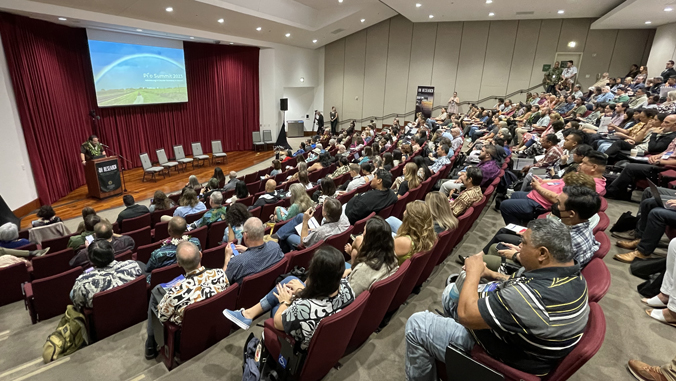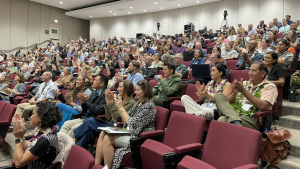
There has been a growing demand for urgent action on issues regarding limited natural resources, biodiversity loss, climate change, energy efficiency, mass waste and pollution. Nearly 300 community leaders, stakeholders and members of the public attended A University of Hawaiʻi Innovation Conference x Piʻo Summit with a goal of creating sustainable solutions for healthy communities in Hawaiʻi and around the world.

Advancing a Circular Economy in Hawaiʻi at the Hawaiʻi Convention Center on December 13 highlighted frameworks, principles, resources and networks of practice that have implemented contemporary applications of ancestral innovation and resource management sciences. The conference was a hub of ideas and actions.
“Solving for a circular economy, fixing the economy here in Hawaiʻi to be more regenerative, less extractive and exploitative of our environment, is something critical for the future of all of Hawaiʻi,” said Kamanamaikalani Beamer, UH Mānoa director at Kamakakūokalani Center for Hawaiian Studies and professor and Dana Naone Hall Endowed Chair in Hawaiian Studies, Literature and the Environment, who delivered the opening keynote and moderated panels on ancestral circular economy, and experiences and best practices of circular economy interventions. “The multiple crises that we faced over these last five years: rain bombs, dramatic fires, poisoning of water, the loss of jobs and security, many of these issues can be solved by reframing our economy to be more robust, more regenerative, between people and place.”
Beamer’s keynote ignited a passion for ancestral circular economies, connecting the past with aspirations for a better world.
Why is a circular economy important?
The pursuit of profit and convenience has led to growing consumerism, throwaway culture and monumental waste, resulting in a linear “take, make, use, waste” economy built on extracting finite resources to create products destined for landfills.
Governments across the globe are searching for solutions that separate economic growth from environmental degradation while ensuring long-term prosperity. In ancestral Hawaiʻi, a “give, take, regenerate” circular system led to the development of balanced structures of resource management. One steadily advancing movement is aimed at designing a “circular economy,” where waste is minimal, materials and resources are preserved for as long as possible, and modes of production mimic nature’s regenerative processes.
The session themes focused on past successes with implementing a circular economy and taking those best practices into the future.
“We don’t solve things instantly. I think we begin though, to set in precedent a new way of understanding of how we enact an island economy given these changes, which are challenges, but the opportunity of the precedent of what’s here that we can pull from this corpus of knowledge,” said Kamuela Enos, director of the UH Office of Indigenous Knowledge and Innovation, who moderated a pair of panels on contemporary restoration of ahupuaʻa (traditional subdivision of land) and UH’s role in creating opportunities for the future.
Advancing a Circular Economy in Hawaiʻi was sponsored by the UH Office of the Vice President for Research and Innovation, The GSI Family of Companies, Elemental Excelerator and Kamehameha Schools in partnership with Piʻo Summit 2023 and Ulupono Initiative. For more information, visit this website.

